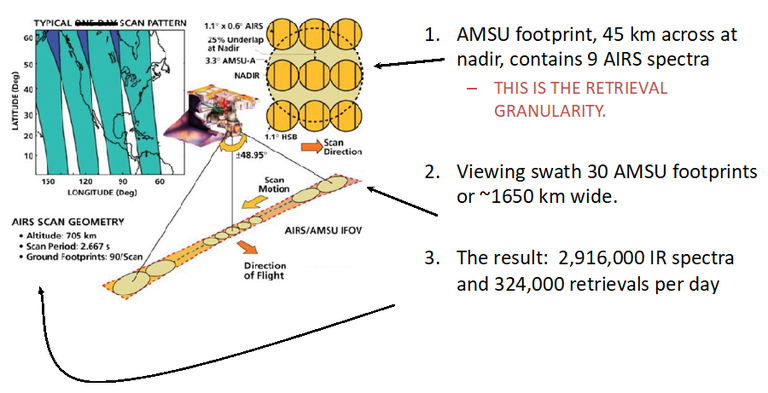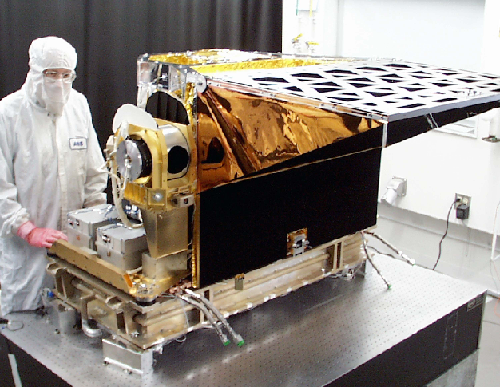Instrument Suite: AIRS, AMSU, HSB
AIRS, AMSU and HSB
At launch, the AIRS suite included a hyperspectral infrared instrument (AIRS) and two multichannel microwave instruments, the Advanced Microwave Sounding Unit-A (AMSU A or AMSU) and the Humidity Sounder for Brazil (HSB). The AIRS instrument also includes an imaging radiometer in four visible and near-infrared bands (referred to as AIRS VIS). HSB stopped operating on 5 February, 2003, but an AIRS/AMSU/HSB product has been available in all data releases. The AIRS/AMSU/HSB viewing geometry is shown in Figure 2 below.
Any combination of AIRS, AIRS/AMSU and AIRS/AMSU/HSB are commonly referred to as “AIRS products” with “microwave-only” referring to products retrieved only from HSB and AMSU radiances. The main source of information in the AIRS retrieval system is infrared radiances. Figure 3 gives an example of a single simulated AIRS infrared spectrum. Examples of observed AIRS, AMSU, and HSB spectra are shown below.
In addition to loss of HSB in 2003, the AIRS observing system has been affected by the steady loss of some AMSU channels. These changes in microwave radiance information have necessitated the development of an AIRS-Only retrieval algorithm.

Figure 2: AIRS, AMSU and HSB observations within a single AMSU footprint, and within an orbital swath.

Figure 3: Simulated AIRS spectrum with prominent spectral features marked.
AIRS/AMSU/HSB viewing characteristics
- AMSU viewing footprints are about 45 km wide at nadir, in a swath 30 footprints wide. Each AMSU scene footprint contains nine AIRS and HSB footprints, each about 15 km across at nadir. See the upper right part of Figure 2 for the instrument viewing geometry.
- AMSU footprints are sampled 15/4 or 3.75 times per seconds, so AMSU observe 324,000 footprints per day.
- AIRS and HSB sample at nine times higher rates than AMSU, or 135/4 or 33.75 footprints per second, or 2,916,000 footprints per day each.
The AIRS Instrument
AIRS (shown in Figure 4) is a continuously operating cross‑track scanning infrared sounder, consisting of a telescope that feeds an echelle spectrometer. The AIRS spectrometer acquires 2378 spectral samples at resolutions, l/Dl, ranging from 1086 to 1570, in three bands: 3.74–4.61 µm (2169–2674 cm−1), 6.20–8.22 µm (1217–1613 cm−1), and 8.8–15.4 µm (649–1136 cm−1). The coverage gaps are apparent in Figure 3.
The scan mirror operates at approximately 265 K, due to radiative coupling to the Earth and space, and to the 150 K IR spectrometer. The infrared focal plane is cooled to about 58 K by a Stirling/pulse tube cryocooler. Cooling of the infrared optics and detectors is necessary to achieve the required instrument sensitivity. The AIRS instrument is described in detail in (Morse et al, 1999).

Figure 4: The Atmospheric Infrared Sounder (AIRS) shown at BAE SYSTEMS prior to delivery for spacecraft integration.
Fields of view
The fields of view of the infrared channels have a solid angle width about 1.1 degrees in diameter, which corresponds to about 15 km in the nadir. These are the smaller circles in Figure 2. During each scan, the rotating external mirror observes the underlying Earth scene from 49.5° on one side of the nadir to 49.5° on the other side, in 90 steps, obtains two additional views of dark space (one before and one after the Earth scene), one view of an internal radiometric calibration target, and one view of an internal spectral calibration target. Thus, each scan produces 94 sets of measurements (90 earth scenes and 4 calibrations). The scan is repeated every 8/3 seconds. The downlink data rate from the AIRS instrument is 1.2 Mbit/sec.
Radiometric stability and performance
The stable and precise radiometric performance of the AIRS instrument is the foundation of the AIRS data record. The Noise Equivalent Temperature Difference (NEdT) for AIRS ranges from 0.1K to 0.8K for individual channels, with a radiometric accuracy of better than 250 mK (one standard deviation) in most channels (Pagano et al., 2020).
The AIRS radiances at the 1231 cm−1 window channel show excellent stability relative to independent SST estimates, with a drift of less than 0.2–0.3 milliKelvin per decade, from 2002 to 2019 (Aumann et al., 2019). The spatial response functions of each AIRS channel were measured pre-flight and showed uniform response for most channels. Channels near the ends of detector modules have sufficiently different response that they can impact radiometry in non-uniform scenes (see Pagano et al., 2015).
The AIRS spectrum is calibrated to better than 1 ppm (roughly 0.001 cm−1) using absorption features in the upwelling spectrum, and spectra are corrected for time varying spectral calibration, including Doppler shifts from Earth’s rotation (Strow et al., 2006; Pagano et al, 2020). Spectral calibration data are provided separately in calibration properties files by epoch.
Corrections to the spatial non-uniformity and spectral drifts, along with cleaned and gap filled radiances (using principal component reconstruction) are available in a new Level 1C product. The Level 1C product resamples the spectra to a common set of frequencies for the entire mission. More information is found in the AIRS Level 1B, and Level 1C user guides.
Visible/Near-Infrared Imager on AIRS
In additional to a spectrometer, the AIRS instrument includes a Visible/Near-Infrared (Vis/NIR) imaging photometer with four spectral bands, each with nine pixels along track. Optical filters in the 400 nm to 1000 nm region to determine the four spectral bands. The Vis/NIR detectors are not cooled and operate in the 293 to 300 K ambient temperature range of the instrument. The pixel fields of view subtend a solid angle 0.185 degree wide, for a spatial resolution at nadir of 2.3 km. AIRS obtains eight cross-track samples of each Vis/NIR detector as the mirror sweeps across one of the 90 AIRS footprints in a scan. The Vis/NIR imager is coaligned with the infrared spectrometer to enable simultaneous measurements of the Vis/NIR and infrared scene. The Vis/NIR channels provide diagnostic support to the infrared retrievals by detecting low clouds or highly variable surface features within the infrared field of view (Broberg et al., 2017).
AMSU-A Instrument
AMSU‑A is a 15‑channel microwave sounder implemented as two independently operated modules. Module 1 (AMSU‑A1) has 12 channels in the 50 to 58 GHz oxygen absorption band. These provide the primary temperature sounding capabilities at microwave frequencies.
A channel at 89 GHz provides surface and moisture information. Module 2 (AMSU‑A2) has 2 channels, at 23.8 GHz and 31.4 GHz, which provide surface and moisture information (total precipitable water and cloud liquid water).
Like AIRS, AMSU‑A is a cross‑track scanner. The three receiving antennas (two for AMSU‑A1 and one for AMSU‑A2) are parabolic focusing reflectors mounted on a scan axis at a 45° tilt angle, so that microwave radiation is reflected from a direction along the scan axis (a 90° reflection). AMSU‑A scans three times as slowly as AIRS (once per 8 seconds) and its footprints are approximately three times larger than those of AIRS (an angular width of about 3.3 degrees, or 45 km at nadir). This results in three AIRS scans per AMSU‑A scan and nine AIRS footprints per AMSU‑A footprint.
AMSU Performance History
Some AMSU channels have been slowly losing sensitivity, and AMSU A-2 failed entirely in 2016. Here is a summary of AMSU performance issues over time:
- AMSU channel 4 failed 1 October 2007 with radiances useful until mid-2007.
- AMSU channel 5 progressively degraded beginning January 2010.
- AMSU channel 7 exhibits abnormal noise levels and should not be used.
- AMSU-A2 with its channels 1 and 2 failed on 24 September 2016.
- AMSU channel 14 scene temperature underwent a sudden drop in brightness temperature of about 4 K on 21 June 2018 but recovered, with temperatures increasing by about 4 K on 19 June 2019. The cause is not known.
HSB Instrument
The Humidity Sounder for Brazil (HSB) is a 4‑channel microwave moisture sounder implemented as a single module. Three channels are located near 183 GHz, while the fourth is a window channel at 150 GHz. HSB is nearly identical to the AMSU‑B instruments operated by NOAA on its operational weather satellites, but HSB lacks the fifth channel (89 GHz) of AMSU‑B. HSB has a single parabolic scan antenna, and like AIRS and AMSU is a cross‑track scanner. Its scan speed and viewing footprint are similar to AIRS, giving one HSB footprint per AIRS footprint and nine per AMSU footprint. HSB ceased operation on February 5, 2003 due to a failure in the mirror scan motor electronics.
